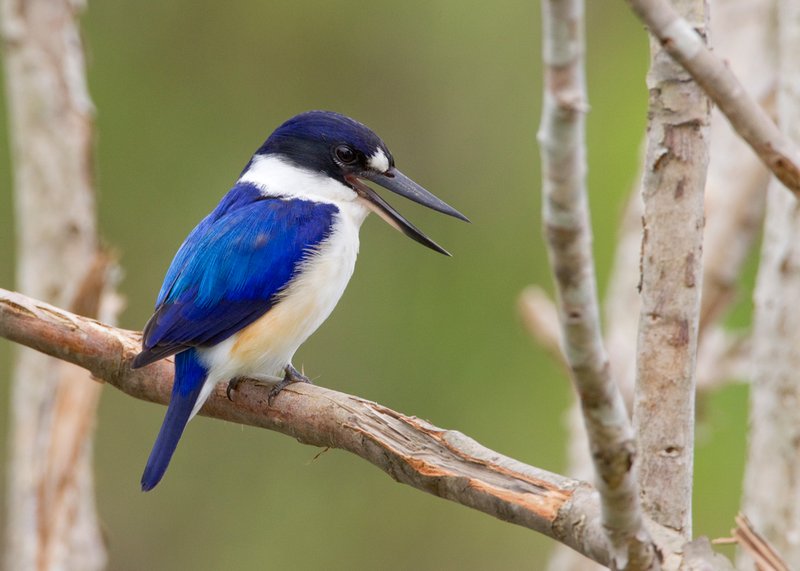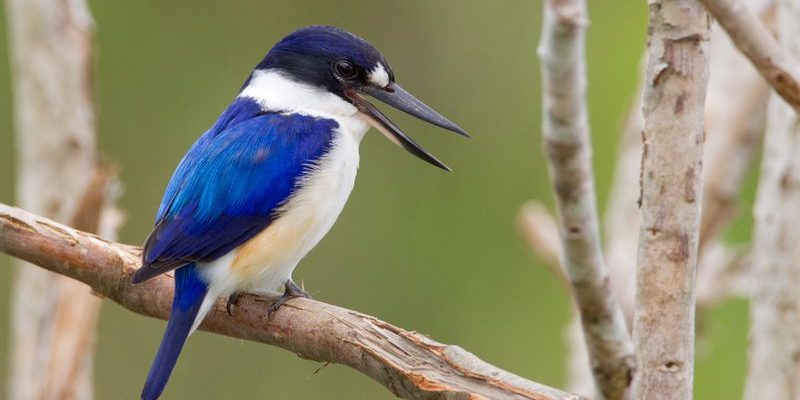
The Forest Kingfisher is a stunning bird that stands out in the vibrant tapestry of the rainforest. Imagine walking through a dense, green forest, where the only sounds are the rustling leaves and distant bird calls. Suddenly, you catch a flash of bright blue or emerald green darting between the trees. That’s likely the Forest Kingfisher, a bird that can take your breath away with its beauty and grace. Not only is this bird a feast for the eyes, but it also plays a vital role in its ecosystem.
You might be wondering what makes the Forest Kingfisher so unique. Beyond its brilliant colors, this bird exhibits fascinating behaviors and adaptations that allow it to thrive in its natural habitat. These birds are skilled hunters, often seen perched quietly, waiting for the perfect moment to dive down for their next meal. As you read on, you’ll discover everything from their diet to their nesting habits, unfolding the mystery behind this incredible avian species.
Physical Characteristics
The Forest Kingfisher is a small to medium-sized bird, typically measuring around 24 to 30 centimeters in length. One of its most striking features is its vibrant plumage, which displays a kaleidoscope of colors—ranging from deep blues and greens to splashes of white and orange. This striking appearance not only makes them a joy to observe but also helps them camouflage among the colorful flowers and foliage of their rainforest home.
Their beaks are another notable characteristic. They possess long, pointed bills that are specially adapted for hunting. This gives them an edge when catching fish or insects, as they can dive with precision. Their eyes are large and keen, providing excellent vision that aids in spotting prey from a distance. You could say that their appearance and physical traits are perfectly tailored for life in the wild.
Habitat
The Forest Kingfisher primarily resides in tropical forests, especially near bodies of water such as rivers and streams. These habitats provide them with an abundance of food and shelter. You will often find these birds perched on branches overhanging water, where they can quickly plunge into the water to catch fish or snatch insects from the surface.
Not only do they prefer lush, dense areas of forest, but they are also known to adapt to secondary growth forests. As the world changes, so does this resilient bird. Whether it’s a pristine rainforest or a recovering area, the Forest Kingfisher finds ways to thrive. However, they are sensitive to habitat destruction, and any loss of their forest home can have devastating effects on their population.
Diet and Hunting Behavior
The diet of the Forest Kingfisher mainly consists of small fish, crustaceans, and insects. Their hunting style is quite fascinating. They often sit silently on a branch, camouflaged by their colorful feathers, watching for movement in the water below. When they spot a target, they take off in a flash, diving headfirst with incredible speed.
This hunting technique is not just about speed; it’s also about patience. They can spend long periods waiting for the right moment to strike. This strategy is vital because even a moment of distraction can mean missing a meal. Their ability to adapt their diet based on the availability of food is one of the reasons they’ve managed to thrive in various environments.
Reproduction and Nesting
When it comes to reproduction, Forest Kingfishers typically nest in tree hollows or burrows that they excavate themselves. The nesting process is crucial for their survival, as it provides a safe place for their young. A typical clutch consists of about 3 to 5 eggs, which are incubated for around 18 to 20 days before hatching.
After the eggs hatch, both parents share the responsibility of feeding their chicks. This teamwork not only helps ensure that the young birds get enough food, but it also strengthens the bond between the pair. As the chicks grow, they become more demanding, and the parents tirelessly hunt to keep their growing family fed.
Conservation Status
The conservation status of the Forest Kingfisher is a topic of concern. Habitat loss due to logging, agriculture, and urban development poses significant threats to their population. While they are not currently classified as endangered, the continued degradation of their environment could push them toward that status if action is not taken.
Conservation efforts are vital to protect their habitats and ensure that future generations can enjoy the beauty of the Forest Kingfisher. Preserving rainforests and promoting sustainable practices are essential steps we can all take to support these magnificent birds. Just as they play a role in their ecosystem, we too have a role in ensuring their survival.
| Characteristic | Details |
| Size | 24 to 30 cm in length |
| Habitat | Tropical forests, especially near water bodies |
| Diet | Small fish, crustaceans, insects |
| Breeding Season | Generally between spring and summer |
| Eggs per clutch | 3 to 5 eggs |
Behavior and Social Structure
The Forest Kingfisher tends to be a solitary hunter, but they are not entirely antisocial. During breeding season, you might see pairs working together to protect their territory and raise their young. Their vocalizations are an essential part of their communication, ranging from soft whistles to loud calls that can be heard echoing through the trees.
Even outside of mating season, these birds can be quite vocal. Their calls serve various purposes, from establishing territory to warning off intruders. If you were to sit quietly in the forest, you might be treated to a concert of chirps and whistles, each one carrying a message. It’s a reminder of the intricate social lives these birds lead, even when they seem so solitary.
Interesting Facts
Did you know that the Forest Kingfisher is often mistaken for other kingfisher species due to its vibrant colors and similar size? Identifying them can be tricky, but their unique behaviors and habitat preferences can help you distinguish them. Another fun fact is that these birds are known to be quite territorial; they defend their nesting areas fiercely against others of their kind.
Another captivating aspect of the Forest Kingfisher is their hunting agility. Watching them dive for prey is like seeing a natural acrobat in action. Their ability to adjust their hunting technique based on the type of prey available showcases their intelligence and adaptability in the wild. Isn’t it amazing how these birds have evolved to thrive in their environments?
FAQ
Where can I find Forest Kingfishers?
You can typically find Forest Kingfishers in tropical rainforests, often near rivers and streams. They prefer habitats that provide ample shelter and food sources. If you’re looking to spot one, consider visiting rainforests in Southeast Asia or certain regions in Australia, where these birds are more prevalent.
What do Forest Kingfishers eat?
Forest Kingfishers primarily feed on small fish, insects, and crustaceans. They have a keen hunting technique that involves watching from a perch and diving to catch their prey. Their diet can vary based on the availability of food in their habitat—if fish are scarce, they might target insects instead.
Do Forest Kingfishers migrate?
Unlike some bird species, Forest Kingfishers are generally non-migratory. They tend to stay within their established territories year-round unless there are drastic changes in food availability or habitat. They rely on the consistent resources available in their tropical forest environments.
How long do Forest Kingfishers live?
In the wild, Forest Kingfishers typically live for about 5 to 10 years. However, factors like predation, food availability, and habitat destruction can impact their life span. Those in protective environments, like reserves or captivity, might live longer due to the absence of such stresses.
Are Forest Kingfishers good pets?
While Forest Kingfishers are beautiful birds, they are not suitable as pets. They have specific habitat and dietary needs that are challenging to replicate in a home environment. Additionally, keeping wild birds as pets is often illegal and can harm their populations in the wild. It’s best to admire these fascinating creatures in their natural habitat.
What makes the Forest Kingfisher unique?
What sets the Forest Kingfisher apart is not just its spectacular colors but also its remarkable hunting skills and adaptability. Their ability to thrive in various rainforest environments and their unique nesting habits make them a fascinating subject for bird watchers and nature enthusiasts alike. They embody the rich biodiversity of the forests they inhabit.
How do Forest Kingfishers communicate?
Forest Kingfishers communicate through a variety of vocalizations, including whistles and calls that serve different purposes, from establishing territory to warning off rivals. Their vocal repertoire is a crucial part of their social interactions, especially during the breeding season when they need to coordinate with their partners and defend their nesting areas.
What is the best time to observe Forest Kingfishers?
The best time to observe Forest Kingfishers is during the early morning or late afternoon when they are most active. They are seen hunting and foraging during these times, and the cooler temperatures make for an enjoyable birdwatching experience. Just be patient and quiet, and you might catch a glimpse of these beautiful birds in action.
How do Forest Kingfishers find their mates?
Forest Kingfishers find their mates through a combination of vocal displays and visual courtship behaviors. Males often perform elaborate displays to attract females, showcasing their colors and agility. Once paired, they establish and defend a territory together, which is crucial for successful breeding.
What threats do Forest Kingfishers face?
Forest Kingfishers face significant threats from habitat destruction due to logging and land conversion for agriculture. Environmental changes, such as climate change and pollution, also impact their food sources and nesting sites. Conservation efforts are crucial to protecting their habitats and ensuring their survival in the wild.
How can we help protect the Forest Kingfisher?
You can contribute to the protection of the Forest Kingfisher by supporting conservation initiatives focused on preserving rainforests and their ecosystems. Educating others about the importance of biodiversity and advocating for sustainable practices can also make a difference. Every small effort counts in ensuring that these magnificent birds continue to flourish in their natural habitats.

